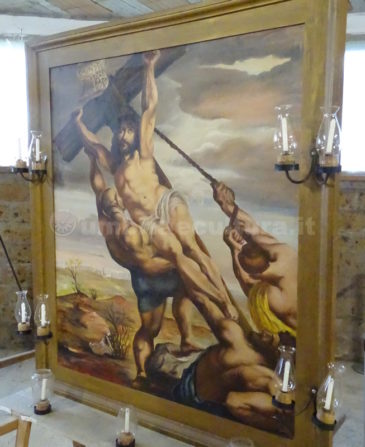The Good Friday Procession in Bagnoregio, one of the oldest events in the Lazio region, has been a local tradition for more than 400 years.
As the legend is told, during a devastating plague, which ravished the area around Bagnoregio (Lazio) in 1449, an old woman of great faith went every day to her church in the village of Civita, now one of the most famous hill towns in Italy. There, the old woman prayed fervently before the church’s ancient wooden cross, asking her Lord to end the plague. One day, while kneeling in prayer, she was astonished to hear the wooden cross speak to her. The cross comforted her with a promise that the Lord had heard her prayers and would end the misery and suffering. Just a few days later, the old woman passed away and, miraculously, the plague immediately vanished.
For more than 200 years thereafter, the wooden cross, which became known as the Most Holy Crucifix, was revered and prayed to by all of the citizens of Civita. Then, according to early archival documents, on the evening of Good Friday in 1660 the Venerable Confraternity of San Pietro first carried the Most Holy Crucifix through the ancient streets of Civita, beginning a venerable Easter tradition that continues to the present day.
For many years, the Processione del Venerdì Santo di Bagnoregio (the Good Friday Procession of Bagnoregio) took place only in the village of Civita. In 1851, however, Canon Leandro Marini, a priest in the neighboring city of Bagnoregio, asked the Venerable Confraternity of San Pietro if they would be willing to move their Good Friday Procession to the much larger city of Bagnoregio. The Confraternity agreed, on two conditions. The first condition was that Bagnoregio must use torches to clearly illuminate the darkest parts of the procession route so that the bearers of the Most Holy Crucifix could see all of the potholes, loose stones, and other irregularities in Bagnoregio’s rough, unpaved streets. The second condition was that Bagnoregio had to return the Most Holy Crucifix to the village of Civita immediately after the Procession, giving rise to the now popular belief that, if the Most Holy Crucifix does not return to Civita by midnight, ownership of the sacred relic would pass to the people of Bagnoregio.
The Good Friday Procession now features three thematic: a historical segment, a folklore segment, and a religious segment.
The Procession begins with the historical segment, a representation of the agonizing journey Jesus endured on the way to his crucifixion. More than 150 costumed local participants pass by in turn. First come Romans on foot and on horseback, followed by Pontius Pilate’s chariot, the twelve apostles and priests of the Sanhedrin, a group of Jewish guards and, lastly, the Madonna accompanied by both pious and common women.
In the folklore segment, the Procession showcases a series of figurative works representing the acts of the last days of the life of Jesus. The figurative works are lit by candles and mounted on sedans carried on the shoulders of young bearers. .
At last, in the religious segment, spectators watch in reverent silence as the ancient and splendid Most Holy Crucifix of Civita di Bagnoregio passes by.
A multitude of traditional lanterns line the route of the Procession, giving the entire event a mystical glow and deep religious significance that the spectators will never forget.
Find Civita di Bagnoregio on Google Maps:




